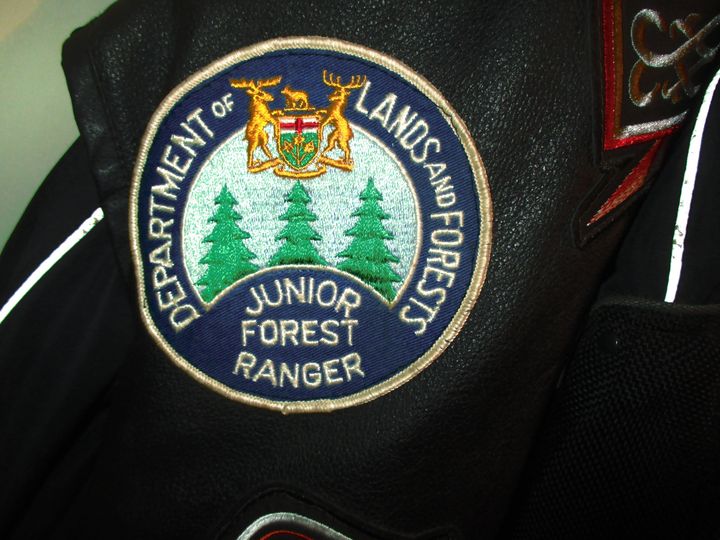RICHARD D. ROBINSON ONTARIO JUNIOR RANGER 1943 2024-01-01
In 1943 the then Lands & Forests flew a trial balloon for a youth program that led to the Ontario Junior Ranger program that officially began in 1944. Richard Robinson, “everyone calls me Dick”, spent his summer of 1943 as a Junior Ranger in Algonquin Park. The following is from an MNR transcript interview in 2004 when Dick was 76.
Around the end of June 1943 (during WW2) I went to Union Station and took the train to Scotia Junction. I had never heard of it. There was almost noone on that train. I saw a boy so I sat beside him and soon discovered that he was a JR also. When we got off the train at the Junction there was nothing but a water tower. We transferred to an eastbound train to Algonquin Park and Cache Lake headquarters. We stayed at the staff house. The Highland Inn wasn’t open because it was June before the tourist season. Jim Taylor was the Park Superintendent. (Note: Jim was Henry Taylor’s older brother. More about Henry can be read elsewhere on this website. Henry celebrated 100 years September 19, 2004.)
We were going to Camp 4, four miles east of the Park’s West Gate on Highway 60. While waiting for more boys to arrive we spent a day helping load telephone poles onto a truck at Park Headquarters. There were so many poles that the front tires were lifted off the ground.
Camp 4 was an abandoned bunkhouse, all that remained of a lumber camp on the banks of the Oxtongue River. My research leads me to believe that this camp once belonged to the Gilmour Lumber Company of Trenton, Ontario.
There were 9 boys of my age and two adults. Joe Gossen the boss foreman and Joe Jepeske the Polish cook were both from Whitney. Porcupines lived under the wooden floor and had chewed big holes in the floor. One was beside my bed. Many nights I was awakened by the “chew, chew, chew”. I would get my flashlight and there would be an old porcupine with his head in the hole. I would get my axe and whack the floor to chase the porcupine so I could go back to sleep.
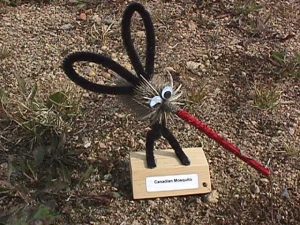
When I was first hired I was told that I was going to Pembroke. I had arranged for transportation there on a Canada Bread Truck. My next door neighbour was the manager for Canada Bread that shipped bread to Pembroke. About two days before I was to leave I got the word that I was going to Algonquin Park instead to scrub out the telephone line which was a provincial government line owned by the Department of Lands & Forests between Park Headquarters and Huntsville. The line ran along the edge of Highway 60, a dusty gravel road. We used our sickles and axes to chop the saplings, brush and scrub that interfered with the telephone line. We would do about a mile a day. It was a dirty, miserable, unpleasant job because every car that blew by created clouds of dust. Then there were wasp and hornet nests, the mosquitoes were terrible, the black flies and so on and so forth. It was extremely hot in the summer and we normally worked stripped to the waist. One day Mr. Gossen said we had to put on our shirts because of a complaint from a woman driving by. She thought it was inappropriate and she went to Mr. Taylor.
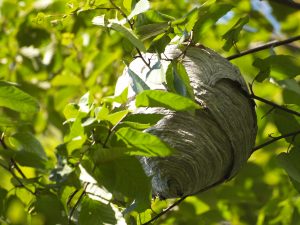
There was no recreation in this camp so we killed time in the evening after supper sharpening our axes and sickles on a grindstone. The boys living quarters were separate from the adults. I never saw the inside of their quarters. The Cook got up very early and started breakfast in the open bunk house area. The rest of the building was filled with cots and beds. Sometimes Gossen would have to tell us lads to shut up so the cook could get some sleep.
One of the guys had some clippers and we decided to cut our hair with a path down the centre of the top of the head. Gordie, the only local lad from Madawaska, was tough as nails and he would have nothing to do with that. The next morning when the boss came out and saw the 8 of us, well, you get the picture (“Ha, ha”).
We worked Saturday mornings like everyone else and in our time off in the afternoon Mr. Gossen took us to a nearby sawmill. I will never forget it because it was startling to see how many workers were missing fingers, hands, forearms, whole arms, just from working in the sawmill.
There was a truck at Camp 4 but we never used it. I don’t know why it was there. I was the only one with a driving license. It was a different world then – no bug juice, jackets, safety equipment… One day Jim Taylor came and wanted the truck at headquarters. This was July, my birthday was in May, I was 16 years old and I was the guy who had to take the truck back. I had never driven a truck, just the family car, a 35 Ford. I knew nothing about changing gears but assumed it was like our Ford. Fortunately there was little traffic partly because of the war and nobody could get gas anyway. I came to a big hill and the engine started getting “chuggier and chuggier” until she quit. I didn’t know how to change the gears to get to the top so I had to take a run at it. I barely got to the top of that hill. A week or two later Joe asked if I had any trouble during the trip. Taylor had said there was no oil left in the truck.
The food was terrible. It was not what city folks were used to. The so called meat must have been the pig’s underbelly because it was nothing but solid lardy fat. I had never eaten anything like it. After a while I was elected to speak to the foreman to ask if we could have some decent meat.
I remember him saying “What, you don’t like that meat? That’s terrific meat.”
When I returned to the city in September I was talking to my neighbour who worked at the parliament buildings in the Dept. of Lands & Forests in the Accounting department. She asked how my summer was and when I told her the food was very poor and about the meat. She said she couldn’t believe that because I see the accounts from that place, they all cross my desk. I see roasts and chops; you name it. In hindsight I understand exactly what was happening. These two guys lived in Whitney. Once a week they would go to Mrs. Bornavich’s grocery store in Whitney and buy supplies. No doubt they would stop at home before they returned to camp.
It was interesting to see the cook prepare breakfast. For so called boiled eggs he would break the egg with one hand and with the other hand ladle the egg out before it hit bottom and it was done. Fried eggs, yeah, (“Ha, ha”); coffee was similar. Throw a handful of coffee grinds into boiling water and pour immediately and that was coffee.
I was born in 1927 and raised by parents who had gone through the depression. I went to make some money, to get out of the city and have some adventure. I had never been to the Park before.
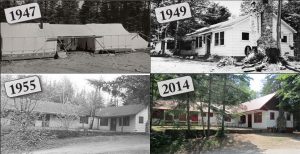
In 1945 Dick worked at Lake of Two Rivers. I got the job through Jim Bailey of the ROM (Royal Ontario Museum). Dr. Doug Clark was in charge of starting the Wildlife Research Station at Lake of Two Rivers. He hired 6 or 7 high school or university students. Dalton Muir and I were in the last year of high school. The university students were doing so-called biological research and another man from the ROM, Cliff, was stuffing animals and birds. We had to cut survey lines through the bush. They were live trapping mice and shrews.
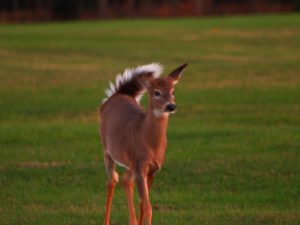
One night we live trapped a deer. We were living in an abandoned logging bunk house at Lake of Two Rivers. The windows were gone so we covered them in mosquito netting. One night we were awakened by a noise and there was a black bear on the table trying to open a can of jam. You can imagine the chaos with all of these guys. The bear escaped through the window covered in that white netting. In a live trap we caught a deer and tagged its ear.
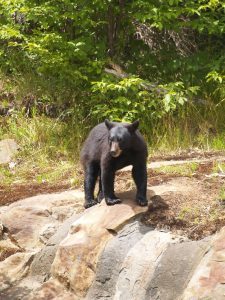
In 2002 I returned to see the area we had cleared for the research lab. A few feet from where I parked he car was a granite boulder and on it is a plaque that said something like “this plaque is dedicated to a group of young men who in 1945 started this place”. I thought that was nice. I am still surprised that someone would remember we kids and put up a plaque.
Early in high school I became interested in bird photography. Dalton Muir came to me in 1942 and said he also was interested and we photographed birds our entire adult life. Best friends, we were best men at each other’s wedding. He died of cancer.
I worked at Eaton’s Camera counter after high school; then as a photographer for the Department of Lands and Forests for 7 years. Then I worked at Kodak for 33 years in marketing. Dalton graduated as a biologist and did that and nature photography for the National Film Board; then to national parks and the Canadian Wildlife Service.
In 2003 Dalton’s granddaughter worked at Sioux Lookout cleaning up a dump. The nice part was the canoe trips when they cleaned portages. It was 24 hours from T.O.
